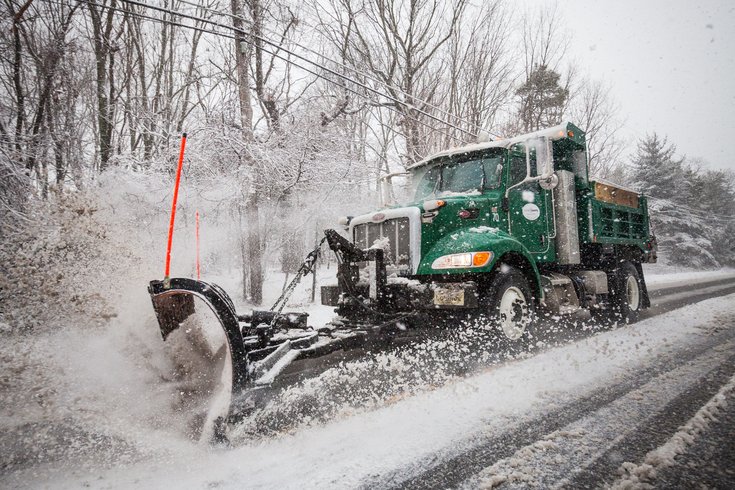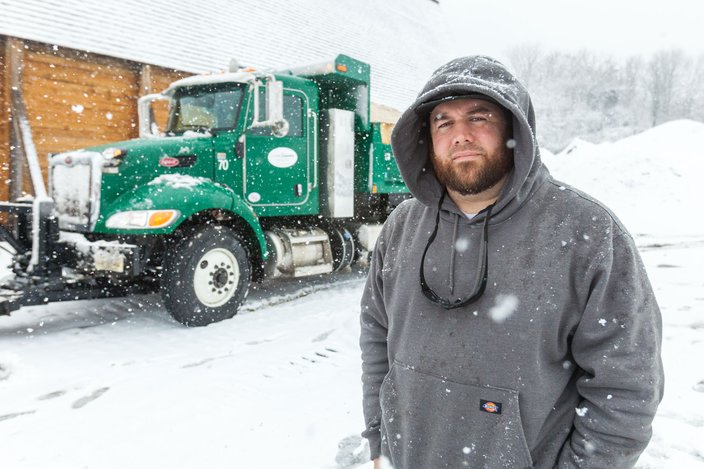At an out-of-the-way public works facility in Camden County, a dump truck with a plow slows to a halt so the driver, a large bearded man sporting a black Eagles hat, can talk to his boss.
The boss had already agreed to let a PhillyVoice reporter accompany the driver on a route during Thursday’s storm to get a firsthand look at the plowing operation.
The driver just didn’t know it yet.
“Sometimes [my three children] are sleeping and they wake up wanting to know where I am.” said Kurt Cunane, who added he has family nearby to help with day care during big storms. “If I didn’t have that, it would be tough to manage.”
An administrator with the Department of Public Works stepped up to the truck’s window and told Kurt Cunane that he was about to clear snow while being interviewed.
In a hushed voice meant to be out of earshot, Cunane said, “I don’t want to be on the news.”
But it's clear why Cunane was selected for the assignment. Friendly and helpful, he was quick to point out that his boss seems to find these kinds of surprises amusing.
Apparently you have to have a sense of humor when battling nature.
Cunane, 35, is a full-time equipment operator and part of a team of drivers responsible for moving snow and ice off roads in Camden County, work that pulls them away from their families on short notice and for many, many hours at a time, often for several days straight. Occasional sleep breaks are short and are taken in the trucks' spartan cabs or a gym cot.
The extended shifts can challenge the mental alertness of drivers; mistakes can lead to crashes, property damage or unsafe streets.
“The people who do this will be in for two days,” said Ian Leonard, a Camden County freeholder who is the liaison to the Department of Public Works. Historically, larger storms can keep people on the job for three days straight.
After taking a left out of the county’s Lindenwold facility, Cunane travels a short distance to his designated section of the county, through towns like Berlin, and meets another plow driver. After a brief conversation, they team up to clear a wide lane from the center to the curb. With Cunane’s plow in front, they form one-half of an upside down “V” to push the snow collectively toward the side.
Immediately, a problem becomes clear. Snow not only moves to the side when the plow is down but large clumps fly straight up and into the windshield. Despite a lack of any real accumulation early in the storm, it rapidly coats the windshield.
“If you are going fast, it will just explode everywhere,” Cunane said.
Cunane slows the truck when the problem worsens – plows on most roads should travel around 20 mph, he said – and makes sure the windshield wipers aren't obstructed. At one point he gets out and brushes off the caked-on snow.
Cunane takes care not to drop the plow hard into the pavement – slamming it could break the softened bottom, called a blade. A replacement costs a few hundred dollars. Cunane constantly tweaks the plow’s height in order for the blade to glide gently along the surface instead of jamming it into potholes and protruding manhole covers.
Kurt Cunane and his plow truck. (Thom Carroll/Phillyvoice.com)
His route takes him through residential neighborhoods and over main roads well outside the city of Camden. Driving plows has been part of Cunane’s job for the past three years. He has cleared snow from the same route for the last two.
“Guys like to be on the same route because they can learn where the potholes are,” Cunane said.
Plows must clear snow from curb to curb, which makes trees, trashcans and mailboxes potential obstacles.
As Cunane drives the dump truck, he explains that a lever in the cab raises the flatbed so a mound of salt can flow into the spreader attached to the back. It's a tricky operation; you don't want the lifted flatbed snagging a low-hanging tree or power line. This is a common problem for new drivers, he said.
It’s not that any one of these challenges is particularly difficult - it’s that they are constantly present throughout long shifts. Cunane’s shift started at just before midnight Thursday and will end after the storm is over.
Sam Martello, director of the county’s Public Works Department, said that about 90 major pieces of machinery were responsible for cleaning roads, which they measure in lane miles. For example, a mile-long stretch of pavement where cars travel in single lanes in both directions would be two lane miles. Martello said about 1,200 lane miles – about the distance from Philadelphia to Minneapolis – were his responsibility. When the snow slows, the crew also shrinks.
Midway through the 90-minute-or-so run, Cunane stops the plow to note some of its parts - and what can go wrong. With a brand-new truck - there are just 2,600 miles on the odometer – Cunane said his truck has fewer issues than some older plows. If a part does break, however, which the in-cab radio announced had happened to another driver, Cunane keeps some spare parts in the cab.
Most of the maintenance work on trucks, however, is done before the storm when drivers check to make sure everything is running smoothly. If something does go wrong, a mechanic and welder are on hand.
As unpredictable as the weather is each season, so too are schedules for the drivers, a mix of full- and part-timers with DPW.
“You can’t schedule much,” Cunane said of the winter months. “You have to be here when it snows unless you have a legitimate excuse.”
And last year was brutal. Martello had to ration the salt, but he said, with pride, that the county “never ran out.” This year, Martello said there were probably about 12 to 15 winter events; many of them, however, were not severe.
For full-time drivers, plowing done during normal work hours usually doesn’t pay overtime, but long shifts and extra hours do pay more for drivers who want the money. Cunane and his wife have three kids. They both work full time, and the schedule can be hard on the kids, who are ages 1 to 6.
“Sometimes they are sleeping and they wake up wanting to know where I am,” said Cunane, who added that he has family nearby to help with day care during big storms. “If I didn’t have that, it would be tough to manage.”
He also recently bought a new house. So when the overtime came during last year’s heavy winter, he volunteered for whatever hours he could get.
“This is our busy season,” he said.

 Thom Carroll/for PhillyVoice
Thom Carroll/for PhillyVoice
